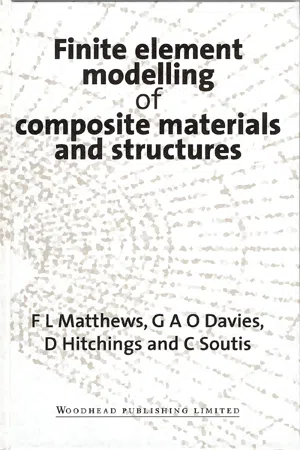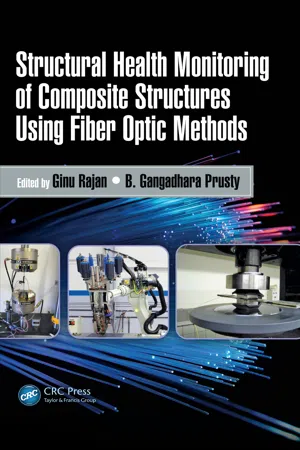Technology & Engineering
Composite Theory
Composite theory is a framework used to understand the behavior of composite materials, which are made by combining two or more constituent materials with different properties. The theory takes into account the interactions between the materials at a microstructural level to predict the overall mechanical, thermal, and electrical properties of the composite. It is essential for designing and engineering advanced materials for various applications.
Written by Perlego with AI-assistance
Related key terms
1 of 5
4 Key excerpts on "Composite Theory"
- eBook - PDF
Mechanics of Composite Materials
Proceedings of the Fifth Symposium on Naval Structural Mechanics
- F. W. Wendt, H. Liebowitz, N. Perrone(Authors)
- 2013(Publication Date)
- Pergamon(Publisher)
SESSION III MICROMECHANICS This page intentionally left blank THEORY OF COMPOSITE MATERIALSt Zvi HASHIN Towne School, University of Pennsylvania, Philadelphia, Pennsylvania 1. I N T R O D U C T I O N We are witnessing these days a veritable composite materials explosion. The impetus for this development is largely due to the search for lightweight materials which can withstand the severe stresses and temperatures en-countered in aerospace environments. The urgency of requirements has led to a situation where technology and scientific theory are being created simultane-ously. While only a few years ago the theory of composites was an esoteric subject which occupied the minds of only a handful of scientists, it has now grown into a foremost research activity producing an ever-increasing amount of reports and papers. Scientific activity proceeding at such sudden pace cannot be devoid of undesirable phenomena. There is much in present work on theory of compos-ites which is of passing or dubious value, in spite of the undoubtedly good intentions of everybody concerned. In the writer's opinion too little emphasis is put on fundamental principles and on reasonable mathematical rigor. Moreover, available results of fundamental importance are all too often sub-merged under a flood of approximations and speculations, based on unjusti-fiable assumptions. The time has come to ask the questions : Is this state of affairs a necessary characteristic of the theory of composites ? Or can this subject be developed as a true scientific theory as has been done in other now well-established fields of applied mechanics and engineering science? This writer believes that the first question should be answered in the negative and the second in the affirmative. It is the purpose of this survey to show that a framework for a sound theory of composites already exists and that it can provide results of great engineering importance. - F L Matthews, G A O Davies, D Hitchings, C Soutis(Authors)
- 2000(Publication Date)
- Woodhead Publishing(Publisher)
Also some features of composite construction, such as filament winding, cannot easily be represented (if at all) by some FE packages. Following a review of com-posites and the FE method, the application of the method to composites is discussed in detail. The particular issues are then illustrated via a number of examples taken from particular situations. Overview 5 2 Fundamentals of composites 2.1 Basic characteristics 2.1.1 Definitions and classification A composite is a mixture of two or more distinct constituents or phases. In addition three other criteria are normally satisfied before we call a ma-terial a composite. Firstly, both constituents have to be present in reason-able proportions. Secondly, the constituent phases should have distinctly different properties, such that the composite’s properties are noticeably different from the properties of the constituents. Lastly, a synthetic composite is usually produced by deliberately mixing and combining the constituents by various means. We know that composites have two (or more) chemically distinct phases on a microscopic scale, separated by a distinct interface, and it is important to be able to specify these constituents. The constituent that is continuous and is often, but not always, present in the greater quantity in the compo-site is termed the matrix. The normal view is that it is the properties of the matrix that are improved upon when incorporating another constituent to produce a composite. A composite may have a ceramic, metallic or poly-meric matrix. The mechanical properties of these three classes of material differ considerably. As a generalisation, polymers have low strengths and Young’s moduli, ceramics are strong, stiff and brittle, and metals have inter-mediate strengths and moduli, together with good ductilities, i.e. they are not brittle. Because of their economic importance, the emphasis in this text will be on polymer matrix composites (PMCs).- eBook - PDF
Composites Manufacturing
Materials, Product, and Process Engineering
- Sanjay Mazumdar(Author)
- 2001(Publication Date)
- CRC Press(Publisher)
Ceramics cannot be processed by common metal- lurgical techniques and require high-temperature equipment for fabrication. Due to their high hardness, ceramics are difficult to machine and therefore require net-shape forming to final shape. Ceramics require expensive cutting tools, such as carbide and diamond tools. 1.1.4 Composites Composite materials have been utilized to solve technological problems for a long time but only in the 1960s did these materials start capturing the attention of industries with the introduction of polymeric-based composites. Since then, composite materials have become common engineering materials and are designed and manufactured for various applications including automotive 4 Composites Manufacturing: Materials, Product, and Process Engineering components, sporting goods, aerospace parts, consumer goods, and in the marine and oil industries. The growth in composite usage also came about because of increased awareness regarding product performance and increased competition in the global market for lightweight components. Among all materials, composite materials have the potential to replace widely used steel and aluminum, and many times with better performance. Replacing steel components with composite components can save 60 to 80% in component weight, and 20 to 50% weight by replacing aluminum parts. Today, it appears that composites are the materials of choice for many engi- neering applications. 1.2 What Are Composites? A composite material is made by combining two or more materials to give a unique combination of properties. The above definition is more general and can include metals alloys, plastic co-polymers, minerals, and wood. Fiber-reinforced composite materials differ from the above materials in that the constituent materials are different at the molecular level and are mechan- ically separable. In bulk form, the constituent materials work together but remain in their original forms. - Ginu Rajan, B. Gangadhara Prusty(Authors)
- 2016(Publication Date)
- CRC Press(Publisher)
1 1 Introduction to Composite Materials and Smart Structures B. Gangadhara Prusty, Ebrahim Oromiehie, and Ginu Rajan 1.1 INTRODUCTION Composite structures are widely used in the aerospace, marine, aviation, transport, sport/leisure, and civil engineering industries [1]. In the past decade, advanced com-posite materials have been widely used in a variety of load-bearing structures such as rotor blades, aircraft fuselage, and wing skins [2]. For example, 52% by weight of the new Dreamliner and 25% by weight of the new Airbus A380 are made from composite materials. The unique properties of composite materials such as their high strength-to-weight ratio, high creep resistance, high tensile strength at elevated temperatures, and high toughness have been attracting increasing interest in numerous applications in different industries such as the automotive and aerospace industries [1,3]. It should be CONTENTS 1.1 Introduction ...................................................................................................... 1 1.2 Composite Materials: Structures and Types ..................................................... 2 1.2.1 Reinforcements ..................................................................................... 3 1.2.2 Matrix ................................................................................................... 4 1.3 Composite Manufacturing Methods and Technologies .................................... 6 1.3.1 Prepreg Layup Method ......................................................................... 6 1.3.2 Wet Layup Method ............................................................................... 7 1.3.3 Spray Layup Method ............................................................................ 8 1.3.4 Filament Winding Method ................................................................... 9 1.3.5 Pultrusion Method ..............................................................................
Index pages curate the most relevant extracts from our library of academic textbooks. They’ve been created using an in-house natural language model (NLM), each adding context and meaning to key research topics.



